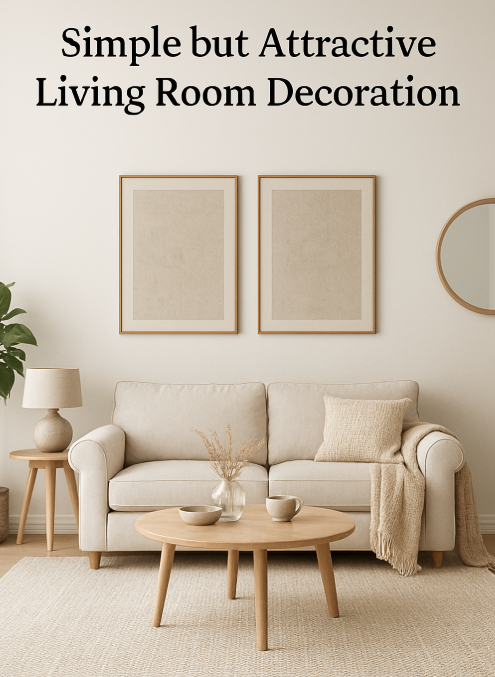Minimalist and Elegant Living Room
In the fast-moving pace of modern life, our homes are increasingly becoming sanctuaries of peace, reflection, and clarity. One design style that perfectly reflects these ideals is minimalism—and nowhere is it more impactful than in the living room. A minimalist and elegant living room doesn’t just look beautiful; it feels calming, organized, and deeply intentional.
This article explores the guiding principles, design techniques, and aesthetic choices behind creating a space that embraces both minimalism and elegance, while also offering practical comfort and timeless appeal.
1. Understanding Minimalist Elegance
Minimalism isn’t about having nothing—it’s about having only what matters. It’s a commitment to thoughtful living, which aligns beautifully with elegance—a concept built on grace, proportion, and subtle sophistication.
A minimalist and elegant living room:
- Uses clean lines and open space.
- Relies on quality materials and subtle textures.
- Prioritizes function without compromising beauty.
- Makes room for light, breathability, and clarity.
2. Choosing a Neutral Foundation
One of the key characteristics of minimalist living rooms is a neutral color palette. This creates a serene, cohesive foundation upon which elegant details can subtly shine.
Popular base colors:
- Warm whites
- Soft beiges
- Light greys
- Muted taupe
These tones work like a blank canvas, allowing furniture, art, and accents to be the focus without visual clutter.
For elegance, add depth with:
- Rich creams
- Hints of charcoal
- Matte black or brass details
Together, these tones feel refined without being loud.
3. The Art of Decluttering
True minimalist elegance begins with editing, not adding. Before designing, take stock of your living room. Remove:
- Items that serve no purpose
- Overly decorative or redundant pieces
- Bulky furniture that crowds the room
Decluttering frees up space, both physically and mentally. What’s left behind should have meaning, function, or beauty.
Remember: Empty space is a design element. It allows the eye to rest and gives importance to what remains.

4. Statement Furniture with Subtle Drama
Furniture in a minimalist and elegant space is often simple in form, but powerful in presence. Look for:
- Sofas with clean silhouettes
- Armchairs with sculptural frames
- Coffee tables made from solid wood or stone
- Floating shelves or low-profile consoles
- Avoid ornate designs. Instead, focus on:
- Proportions
- Materials
- Craftsmanship
For elegance, introduce visual softness. Think curved edges, muted textures, or gentle contrasts like a light oak table on a white rug.
5. Soft Textures and Layers
A common concern with minimalist spaces is that they may feel cold or sparse. This is where texture becomes the hero.
Incorporate:
- A soft wool or jute rug
- Linen or velvet cushions
- Cashmere or knit throws
- Woven baskets or raw ceramics
These add warmth and coziness without disrupting the minimalist look. The goal is tactile comfort that invites touch, not excess.
Layer sparingly. Choose two or three textures and repeat them subtly across the room to tie everything together.
6. Intentional Lighting
Lighting can transform any space, but in minimalist and elegant interiors, it’s especially impactful.
Layer your lighting:
- Ambient lighting for overall brightness (ceiling lights, recessed lighting)
- Task lighting for reading or working (floor lamps, desk lamps)
- Accent lighting for mood and elegance (wall sconces, candles)
Use warm white bulbs for a welcoming glow. Fixtures should have clean lines—brushed brass, matte black, or frosted glass are great choices.
A statement pendant light or minimalist chandelier can also double as a sculptural focal point.
7. Minimalist Wall Decor
In minimalist design, walls are treated with reverence—not cluttered, but not ignored either. Art should:
- Be large enough to command attention
- Reflect calm or abstract themes
- Use neutral or monochromatic palettes
Black and white photography, single-line drawings, or soft landscapes are excellent choices.
Frames should be consistent (wood, black, or white) and clean-lined. Consider:
- One large piece over the sofa
- A pair of vertically stacked prints
- A horizontal gallery of three understated works
Floating shelves can also be used to display curated items, but keep them sparse and intentional.
8. Greenery and Natural Life
Nothing softens a minimalist room like natural elements—especially plants. Greenery adds life, oxygen, and organic shape without overwhelming the space.
Some elegant plant choices:
- Fiddle leaf fig
- Olive tree
- Rubber plant
- ZZ plant
- Monstera
Choose simple, neutral pots—ceramic, concrete, or terracotta. One or two well-placed plants can do more than a dozen scattered ones.
9. Flooring and Rugs
Flooring is the base upon which your minimalist story is told. Hardwood or polished concrete is ideal, as both offer clean, seamless visuals.
A neutral rug defines the living space and provides softness underfoot. Stick to:
- Light solid colors
- Subtle geometric patterns
- Natural fibers
Avoid anything too colorful or ornate. Texture is welcome—shaggy or woven rugs add interest while keeping the look cohesive.
10. Smart Storage, Hidden Beauty
Clutter kills minimalism. To maintain an elegant look, smart storage solutions are essential:
- Low-profile cabinets or sideboards
- Nesting coffee tables with compartments
- Floating media consoles
- Storage ottomans
Use drawers and closed doors to hide everyday essentials—remotes, chargers, paperwork.
Decorative baskets and boxes can also help organize open shelving. The trick is to store without making storage itself a distraction.
11. Elegant Color Accents
While the base of your room should be neutral, that doesn’t mean color is forbidden. In fact, minimalist spaces often use single accent colors to stunning effect.
Popular elegant accent shades:
- Deep navy
- Emerald green
- Dusty rose
- Burnt sienna
- Gold or brass
Introduce color through:
- A single cushion or throw
- A ceramic vase
- A piece of artwork
Use restraint. A pop of color in a room of neutrals has far more impact than several competing tones.
12. Balance and Symmetry
Elegant minimalism thrives on visual balance. This doesn’t mean rigid symmetry, but rather a sense of harmony between the elements.
- Match furniture height when placed side by side
- Align artwork with furniture dimensions
- Pair decor in odd numbers (three candles, two vases of varying height)
Negative space plays a role here too—allow breathing room around key objects.
13. Personalization Without Clutter
Minimalist doesn’t mean impersonal. The most elegant living rooms feature thoughtful personal touches—just not in excess.
Add:
- A favorite book on the coffee table
- A travel souvenir on a shelf
- A framed handwritten note
- A scented candle in a sleek container
Avoid filling every surface. Let each personal item have a spotlight moment, rather than crowding the stage.
14. Designing for Function and Flow
Minimalist elegance isn’t just about looks—it’s about lifestyle. Your living room should reflect how you live:
- Ensure comfortable conversation zones
- Position furniture for natural movement
- Leave room for kids to play or guests to mingle
Functionality adds to the beauty. It makes the room feel lived-in yet composed.
15. Seasonal Refreshes
Keep your space dynamic with small seasonal updates:
- Light linen throws in spring
- Earth-toned cushions in autumn
- Brass candlesticks for winter
- Fresh flowers in summer
These gentle changes bring freshness and inspiration, without needing a complete redesign.
16. Quality Over Quantity
One of the unspoken rules of minimalist elegance: invest in quality. Instead of buying five cheap things, buy one excellent piece.
Whether it’s:
- A handcrafted coffee table
- A designer lamp
- A beautiful wool rug
Well-made items don’t just last longer—they radiate subtle luxury, even in their simplicity.
17. Embracing Imperfection
Lastly, don’t chase perfection. True elegance comes from authenticity. A minimalist room should feel comfortable, not staged. Let a cushion be slightly slouched. Allow a book to rest on a shelf, spine up.
There is beauty in the undone, the asymmetrical, the lived-in. This is what makes minimalist living not just aesthetically pleasing, but emotionally satisfying.
Final Thoughts: Living with Grace and Simplicity
A minimalist and elegant living room is a beautiful fusion of clarity, function, and quiet sophistication. It’s a space that encourages presence, reflection, and serenity—a gentle pause in the noise of the world.
Through careful choices in color, texture, furniture, and layout, you can transform even the smallest space into a haven of calm and style. Remember:
- Less is more
- Every object should have purpose
- Comfort and beauty go hand in hand
In the end, a minimalist and elegant living room doesn’t just look good—it feels right.
Would you like this article formatted for a blog, turned into a downloadable PDF with the image, or translated into another language?


